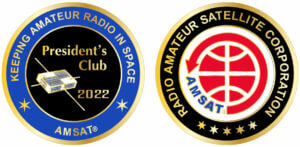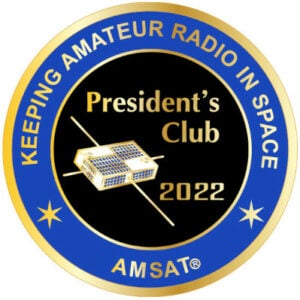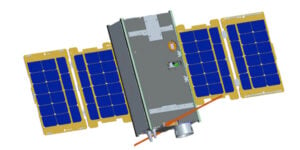In this edition:
* W2RS Memorial AMSAT CW Activity Day to be Held January 1st
* HAARP was used to ping Asteroid 2010 XC15
* Space junk bill passes Senate unanimously
* TJREVERB was deployed from the ISS on December 29, 2022
* Changes to AMSAT-NA TLE Distribution for Jan 1, 2023
* OSCAR number assigned for CAS-10
* ARISS News
* Upcoming Satellite Operations
* Hamfests, Conventions, Maker Faires, and Other Events
* Satellite Shorts From All Over
The AMSAT News Service bulletins are a free, weekly news and information service of AMSAT, The Radio Amateur Satellite Corporation. ANS publishes news related to Amateur Radio in Space including reports on the activities of a worldwide group of Amateur Radio operators who share an active interest in designing, building, launching and communicating through analog and digital Amateur Radio satellites.
The news feed on http://www.amsat.org publishes news of Amateur Radio in Space as soon as our volunteers can post it.
Please send any amateur satellite news or reports to: ans-editor [at] amsat.org
You can sign up for free e-mail delivery of the AMSAT News Service Bulletins via the ANS List; to join this list see: https://mailman.amsat.org/postorius/lists/ans.amsat.org/
ANS-001 AMSAT News Service Weekly Bulletins
To: All RADIO AMATEURS
From: Radio Amateur Satellite Corporation
712 H Street NE, Suite 1653
Washington, DC 20002
DATE 2023 Jan 01 – Wishing All a Happy and Prosperous New Year
W2RS Memorial AMSAT CW Activity Day to be Held January 1st
In March 2022, the AMSAT community lost one of our pioneers when Ray Soifer, W2RS, became a silent key. In addition to his numerous contributions to AMSAT and the worldwide amateur satellite community, Ray was also the long time organizer of AMSAT’s CW Activity Day – previously AMSAT Straight Key Night – held in conjunction with the ARRL’s event on New Year’s Day. In recognition of Ray’s long time service to AMSAT and his keen interest in CW operating via satellite, AMSAT is pleased to announce that AMSAT’s CW Activity Day will now be known as the W2RS Memorial AMSAT CW Activity Day in Ray’s honor.
The rules are simple – operate CW through any amateur satellite between 0000 UTC and 2359 UTC on January 1, 2023. Straight keys and bugs are encouraged, but not required. Logs are not required, but operators are encouraged to submit a report of their activity to the AMSAT-BB. Photos and video clips of activity are also encouraged – post them on Twitter and tag @AMSAT.
Remember to use the minimum power required for communication as constant carrier modes, including CW, can disrupt transponder operation for other users.
[ANS thanks AMSAT for the above information]
+=+=+=+=+=+=+=+=+=+=+=+=+=+=+=+=+=+=+=+=+=+=+=+=+=+=+=+=+=+=+=+=+=+=+
Last Day for 2022 AMSAT President’s Club Membership

When They’re Gone…They’re Gone!
Join the 2022 AMSAT President’s Club today and help
Keep Amateur Radio in Space!
https://www.amsat.org/join-the-amsat-presidents-club/
(2022 membership closes 1/3/2022)
+=+=+=+=+=+=+=+=+=+=+=+=+=+=+=+=+=+=+=+=+=+=+=+=+=+=+=+=+=+=+=+=+=+=+
HAARP was used to ping Asteroid 2010 XC15
Researchers at the HAARP array in Alaska attempted the lowest-frequency asteroid radar experiment ever. On Tuesday, Dec. 27th, they pinged a passing space rock with shortwave radio waves at 9.6 MHz. This could allow them to see *inside* the asteroid.
A number of amateur radio operators around the world were able to copy the signal. The signal appeared in a sequence of frequency sweep pings centered aroun the the 9.6MHz frequency in a “Ping” Wait 2 seconds. “Ping” Wait 2 seconds “Ping” pattern.
That’s what most ham radio operators heard last Tuesday when they received HAARP’s radar transmission to asteroid 2010 XC15. Scott Tilley of Roberts Creek, British Columbia, provided a recording of what he saw. It may be viewed at: https://bit.ly/3C2YshF along with a vidoe that includes sound.
The pulse was lopsided with a fast rise and a slow decay,” notes Tilley. “I believe this is due to multipath propagation from HAARP in Alaska to my receiver in British Columbia.”
Everyone who picked up the pulse did so because Earth’s ionosphere reflected some of HAARP’s radio energy back to Earth. Only a fraction escaped into space and reached the asteroid. Tilley’s high-time-resolution recording of the pulse shows that multiple reflections (probably with a dash of ducting and refraction) were involved.
The complexity of the ionosphere, and how it modifies shortwave signals, is a key challenge for researchers who will be processing radar returns from asteroid 2010 XC15. Good luck to the radar team as we await their results!
[ANS thanks spaceweather.com for the above information]
Space junk bill passes Senate unanimously
U.S. Senator John Hickenlooper applauded Senate passage of his Orbital Sustainability (ORBITS) Act, a bipartisan bill to establish a first-of-its-kind demonstration program to reduce the amount of space junk in orbit. The bill passed the Senate unanimously.
“From satellite communications to rockets carrying humans into deep space, space debris is a massive threat to space operations,” said Hickenlooper, chair of the Senate Subcommittee on Space and Science. “I’m over the moon that our ORBITS Act passed and we can start cleaning up this space junk.”
Space junk, or orbital debris, currently threatens human space exploration, scientific research missions, and emerging commercial space services. There are approximately 8,000 metric tons of debris currently in orbit, including at least 900,000 individual pieces of debris that are potentially lethal to satellites. Because of the magnitude of the current debris, simply preventing more debris in the future is not enough. The ORBITS Act will jumpstart a program focused on research, development, and the demonstration of technologies capable of safely carrying out successful Active Debris Remediation (ADR) missions to create a new market for these services.
Additional information may be found at https://bit.ly/3WwsCCa
[ANS thanks spacedaily.com for the above information]
+=+=+=+=+=+=+=+=+=+=+=+=+=+=+=+=+=+=+=+=+=+=+=+=+=+=+=+=+=+=+=+=+=+
Need new satellite antennas? Purchase Arrows, Alaskan Arrows,
and M2 LEO-Packs from the AMSAT Store. When you purchase through
AMSAT, a portion of the proceeds goes towards
Keeping Amateur Radio in Space.
https://amsat.org/product-category/hardware/
+=+=+=+=+=+=+=+=+=+=+=+=+=+=+=+=+=+=+=+=+=+=+=+=+=+=+=+=+=+=+=+=+=+
TJREVERB was deployed from the ISS on December 29, 2022
TJREVERB, an APRS digipeater 2U cubesat on 145.825 MHz, built by students at the Thomas Jefferson High School for Science & Technology was deployed on December 29, 2022 by NanoRacks from the International Space Station. TJREVERB was launched on November 22 from Kennedy Space Center, Florida as part of the SpaceX-26 Commercial Resupply Service Mission en route to the International Space Station. The launch is the culmination of seven years of hard work for TJ Space. Led by Robotics lab director Kristen Kucko, many students from Thomas Jefferson High School for Science and Technology have had a hand in this historic launch.
A statement and description of the mission by Michael Roth and Kristen Kucko of Thomas Jefferson High School states: “TJ REVERB is significant because the CubeSat was designed, built, coded and integrated entirely by high school students,” said Kucko. “The students did not use a satellite kit, nor did they have an industry or university partnership to assist them. Building satellites is not an easy task. According to Col. Nick Hague, Astronaut, (some)countries have not been able to build CubeSats. The students in TJ Space should be proud of their accomplishments.” Additional information about the project may be found at: https://tjhsst.fcps.edu/features/launch-tjreverb-culmination-seven-year-project-tj-space
Kirsten Kucko, the teacher sponsoring the TJ Space team wrote, “TJ Space received crowdsourced reports that there is an APRS unit digipeating within the vicinity of the ISS. The spacecraft has the orbital characteristics of one of the satellites launched during the NRCSD 24 mission. ” Since TJREVEB is the only CubeSat using APRS in that vicinity, TJREVERB could very well be that spacecraft. It is TJ Space’s assertion that something went critically wrong with TJREVERB’s implementation of the Iridium radio and Iridium did not receive power to turn on. The APRS radio powered on as the backup radio and started digipeating. TJ Space continues to search for confirmation that this spacecraft is indeed TJREVERB.
Any help from the community would be greatly appreciated.
[ANS thanks Michael Roth and Kristen Kucko or Thomas Jefferson High School and JoAnne Maenpaa, K9JKM, for the above information]
+=+=+=+=+=+=+=+=+=+=+=+=+=+=+=+=+=+=+=+=+=+=+=+=+=+=+=+=+=+=+=+=+=+
Want to fly the colors on your own grid expedition?
Get your AMSAT car flag and other neat stuff
from our Zazzle store!
25% of the purchase price of each product goes
towards Keeping Amateur Radio in Space
https://www.zazzle.com/amsat_gear
+=+=+=+=+=+=+=+=+=+=+=+=+=+=+=+=+=+=+=+=+=+=+=+=+=+=+=+=+=+=+=+=+=+
Changes to AMSAT-NA TLE Distribution for Jan 1, 2023
Two Line Elements or TLEs, often referred to as Keplerian elements or keps in the amateur community, are the inputs to the SGP4 standard mathematical model of spacecraft orbits used by most amateur tracking programs. Weekly updates are completely adequate for most amateur satellites. TLE bulletin files are updated Thursday evenings around 2300 UTC, or more frequently if new high interest satellites are launched. More information may be found at https://www.amsat.org/keplerian-elements-resources/
The following satellite has been removed from this week’s AMSAT-NA TLE
distribution:
MYSat 1 NORAD Cat ID 44045 (Decayed from orbit 12/16/2022 per SpaceTrack).
[ANS thanks Ray Hoad, WA5QGD, AMSAT Orbital Elements Manager, for the above information]
OSCAR number assigned for CAS-10
On November 12, 2022, the XW-4 (CAS-10) satellite was launched to the Chinese Space Station aboard the Tianzhou-5 spacecraft, by the Long March-7 Y6 launch vehicle from the Wenchang Launch Center in Hainan, China. On December 18, the XW-4 (CAS-10) satellite was separated from the station. The Chinese Amateur Satellite Group (CAMSAT) built and operates the satellite, in cooperation with a Chinese government space contractor and Macau University of Science and Technology, to serve radio amateurs around the world and educate students in space and radio communication science and technology. This satellite is also known as Macao Student Science Popularization Satellite No. 1, and is the first satellite from the Macao Special Administrative Region. The satellite carries a V/u linear transponder, and CW and GMSK telemetry beacons for amateur radio use.
At the request of CAMSAT and the XW-4 (CAS-10) team, AMSAT hereby designates the satellite as Hope-OSCAR 119 (HO-119). We congratulate all the involved teams, thank them for their contribution to the amateur satellite community, and wish them continued success on this and future projects.
[ANS thanks Drew Glasbrenner, KO4MA AMSAT VP Operations / OSCAR Number Administrator for the above information]
ARISS NEWS
Amateurs and others around the world may listen in on contacts between amateurs operating in schools and allowing students to interact with astronauts and cosmonauts aboard the International Space Station. The downlink frequency on which to listen is 145.800 MHz worldwide.
No School Contacts are currently scheduled.
The latest information on the operation mode can be found at https://www.ariss.org/current-status-of-iss-stations.html
The latest list of frequencies in use can be found at https://www.ariss.org/contact-the-iss.html
[ANS thanks Charlie Sufana, AJ9N, one of the ARISS operation team mentors for the above information]
+=+=+=+=+=+=+=+=+=+=+=+=+=+=+=+=+=+=+=+=+=+=+=+=+=+=+=+=+=+=+=+=+=+
AMSAT, along with our ARISS partners, is developing an Amateur
Radio package, including two-way communication capability, to
be carried on-board Gateway in lunar orbit.
Support AMSAT’s projects today at https://www.amsat.org/donate/
+=+=+=+=+=+=+=+=+=+=+=+=+=+=+=+=+=+=+=+=+=+=+=+=+=+=+=+=+=+=+=+=+=+
Upcoming Satellite Operations
Chris VE3FU / VO2AC / VO1FUA / VE2FUA: The weekend of January 27-29 @Dave_VE3KG and Chris, VE3FU will be competing in the CQ160 CW Contest as VO2AC from the Point Amour Lighthouse in Labrador (Zone 2). They will also be on the other HF bands starting January 24 as VO2AC and VO2AAA. They also plan on operating the linear and FM satellites from grid GO11 as VO2AC and VO2AAA from January 24-27.
[ANS thanks Paul Overn, KE0PBR, AMSAT rover page manager, for the above information]
Hamfests, Conventions, Maker Faires, and Other Events
AMSAT Ambassadors provide presentations, demonstrate communicating through amateur satellites, and host information tables at club meetings, hamfests, conventions, maker faires, and other events.
MSAT Ambassador Clint Bradford K6ALCS has a few satellite presentations scheduled:
-Greenville, North Carolina (1/10/23)
-Ontario, Canada (1/16/23)
-Thames Valley, England (5/11/23)
Ham Radio University will be held 1/7/2023. Registration is now open for this virtual event at https://hamradiouniversity.
[ANS thanks Paul Overn, KE0PBR, AMSAT Events page manager, for the above information]
Satellite Shorts From All Over
+ SpaceX launches first mission for Starlink Gen2 constellation using a Falcon 9 rocket from Cape Canaveral Wednesday with 54 more Starlink internet satellites, a mission to begin populating a new orbital shell authorized by federal regulators earlier this month for the company’s Starlink Gen2 network. Liftoff of the Falcon 9 rocket from pad 40 at Cape Canaveral Space Force Station on SpaceX’s Starlink 5-1 mission occurred at 4:34 a.m. EST (0934 GMT) Wednesday, about six minutes earlier than previously announced. The mission was SpaceX’s 60th launch of the year, with one more Falcon 9 flight set to blast off later this week from Vandenberg Space Force Base, California, with an Israeli Earth-imaging satellite. he 54 satellites launching Wednesday were the first spacecraft deployed into a new segment of the Starlink constellation. The Falcon 9 rocket released the 54 satellites at an orbital altitude and inclination set aside for use by SpaceX’s second-generation Starlink network, which the company eventually intends to launch on the new Starship mega-rocket. More at https://bit.ly/3IcrO0P. [ANS thanks spaceflightnow.com for the above information]
+ An Israeli reconnaissance satellite was carried into orbit during the final SpaceX launch of the year. The EROS-3 Earth-imaging satellite was launched aboard a Falcon 9 rocket from Vandenberg Space Force Base in California at 11:38 p.m. Thursday. The first stage detached successfully and landed on a SpaceX pad eight minutes after launch. The rocket was launched in retrograde, against the direction of the Earth’s rotation, and carried the EROS-3 into low Earth orbit. More information is available at: https://bit.ly/3G8FXJI [ANS thanks Patrick Hilsman, UPI and Spacedaily.com for the above information]
Join AMSAT today at https://launch.amsat.org/
In addition to regular membership, AMSAT offers membership to:
* Societies (a recognized group, clubs or organization).
* Primary and secondary school students are eligible for membership at one-half the standard yearly rate.
* Post-secondary school students enrolled in at least half time status shall be eligible for the student rate for a maximum of 6 post-secondary years in this status.
* Memberships are available for annual and lifetime terms.
Contact info [at] amsat.org for additional membership information.
73 and remember to help Keep Amateur Radio in Space!
This week’s ANS Editor, Jack Spitznagel
kd4iz [at] frawg dot org


 XW-4(CAS-10) satellite adopts a 8U CubeSat structure with a mass of about 12kg, an on-orbit envelope size of 1007x790x475mm with four solar array panels and a three-axis stabilized attitude control system is used, long-term power consumption is about 18.3 Watts.
XW-4(CAS-10) satellite adopts a 8U CubeSat structure with a mass of about 12kg, an on-orbit envelope size of 1007x790x475mm with four solar array panels and a three-axis stabilized attitude control system is used, long-term power consumption is about 18.3 Watts.